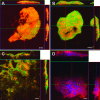Lack of electricity production by Pelobacter carbinolicus indicates that the capacity for Fe(III) oxide reduction does not necessarily confer electron transfer ability to fuel cell anodes
- PMID: 17574993
- PMCID: PMC1950970
- DOI: 10.1128/AEM.00804-07
Lack of electricity production by Pelobacter carbinolicus indicates that the capacity for Fe(III) oxide reduction does not necessarily confer electron transfer ability to fuel cell anodes
Abstract
The ability of Pelobacter carbinolicus to oxidize electron donors with electron transfer to the anodes of microbial fuel cells was evaluated because microorganisms closely related to Pelobacter species are generally abundant on the anodes of microbial fuel cells harvesting electricity from aquatic sediments. P. carbinolicus could not produce current in a microbial fuel cell with electron donors which support Fe(III) oxide reduction by this organism. Current was produced using a coculture of P. carbinolicus and Geobacter sulfurreducens with ethanol as the fuel. Ethanol consumption was associated with the transitory accumulation of acetate and hydrogen. G. sulfurreducens alone could not metabolize ethanol, suggesting that P. carbinolicus grew in the fuel cell by converting ethanol to hydrogen and acetate, which G. sulfurreducens oxidized with electron transfer to the anode. Up to 83% of the electrons available in ethanol were recovered as electricity and in the metabolic intermediate acetate. Hydrogen consumption by G. sulfurreducens was important for ethanol metabolism by P. carbinolicus. Confocal microscopy and analysis of 16S rRNA genes revealed that half of the cells growing on the anode surface were P. carbinolicus, but there was a nearly equal number of planktonic cells of P. carbinolicus. In contrast, G. sulfurreducens was primarily attached to the anode. P. carbinolicus represents the first Fe(III) oxide-reducing microorganism found to be unable to produce current in a microbial fuel cell, providing the first suggestion that the mechanisms for extracellular electron transfer to Fe(III) oxides and fuel cell anodes may be different.
Figures





Similar articles
-
Interspecies electron transfer via hydrogen and formate rather than direct electrical connections in cocultures of Pelobacter carbinolicus and Geobacter sulfurreducens.Appl Environ Microbiol. 2012 Nov;78(21):7645-51. doi: 10.1128/AEM.01946-12. Epub 2012 Aug 24. Appl Environ Microbiol. 2012. PMID: 22923399 Free PMC article.
-
Fe(III) and S0 reduction by Pelobacter carbinolicus.Appl Environ Microbiol. 1995 Jun;61(6):2132-8. doi: 10.1128/aem.61.6.2132-2138.1995. Appl Environ Microbiol. 1995. PMID: 7793935 Free PMC article.
-
Genome-wide gene expression patterns and growth requirements suggest that Pelobacter carbinolicus reduces Fe(III) indirectly via sulfide production.Appl Environ Microbiol. 2008 Jul;74(14):4277-84. doi: 10.1128/AEM.02901-07. Epub 2008 May 30. Appl Environ Microbiol. 2008. PMID: 18515480 Free PMC article.
-
Dissimilatory Fe(III) and Mn(IV) reduction.Adv Microb Physiol. 2004;49:219-86. doi: 10.1016/S0065-2911(04)49005-5. Adv Microb Physiol. 2004. PMID: 15518832 Review.
-
Geobacter: the microbe electric's physiology, ecology, and practical applications.Adv Microb Physiol. 2011;59:1-100. doi: 10.1016/B978-0-12-387661-4.00004-5. Adv Microb Physiol. 2011. PMID: 22114840 Review.
Cited by
-
Multi-heme cytochrome-mediated extracellular electron transfer by the anaerobic methanotroph 'Candidatus Methanoperedens nitroreducens'.Nat Commun. 2023 Sep 30;14(1):6118. doi: 10.1038/s41467-023-41847-w. Nat Commun. 2023. PMID: 37777538 Free PMC article.
-
Direct interspecies electron transfer between Geobacter metallireducens and Methanosarcina barkeri.Appl Environ Microbiol. 2014 Aug;80(15):4599-605. doi: 10.1128/AEM.00895-14. Appl Environ Microbiol. 2014. PMID: 24837373 Free PMC article.
-
Anaerobic oxidation of methane coupled with extracellular electron transfer to electrodes.Sci Rep. 2017 Jul 11;7(1):5099. doi: 10.1038/s41598-017-05180-9. Sci Rep. 2017. PMID: 28698657 Free PMC article.
-
Evolution from a respiratory ancestor to fill syntrophic and fermentative niches: comparative fenomics of six Geobacteraceae species.BMC Genomics. 2009 Mar 11;10:103. doi: 10.1186/1471-2164-10-103. BMC Genomics. 2009. PMID: 19284579 Free PMC article.
-
Long-term enriched methanogenic communities from thermokarst lake sediments show species-specific responses to warming.FEMS Microbes. 2020 Oct 24;1(1):xtaa008. doi: 10.1093/femsmc/xtaa008. eCollection 2020 Sep. FEMS Microbes. 2020. PMID: 37333957 Free PMC article.
References
-
- Bond, D. R., D. E. Holmes, L. M. Tender, and D. R. Lovley. 2002. Electrode-reducing microorganisms that harvest energy from marine sediments. Science 295:483-485. - PubMed
Publication types
MeSH terms
Substances
LinkOut - more resources
Full Text Sources
Other Literature Sources
Molecular Biology Databases

